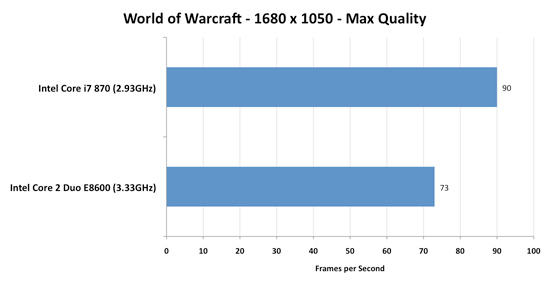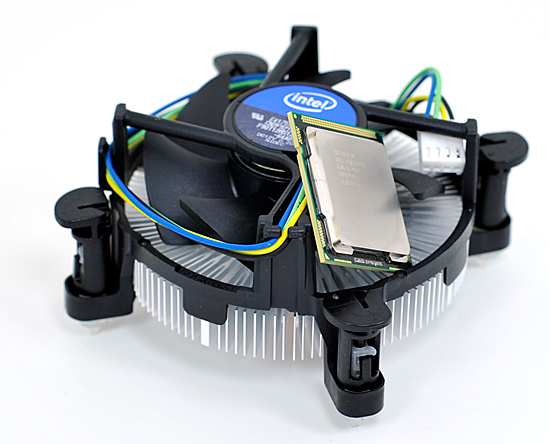Intel's Core i7 870 & i5 750, Lynnfield: Harder, Better, Faster Stronger
by Anand Lal Shimpi on September 8, 2009 12:00 AM EST- Posted in
- CPUs
Lynnfield's Turbo Mode: Up to 17% More Performance
Turbo on Bloomfield (the first Core i7) wasn't all that impressive. If you look back at our Core i7 article from last year you'll see that it's responsible for a 2 - 5% increase in performance depending on the application. All Bloomfield desktop CPUs had 130W TDPs, so each individual core had a bit more breathing room for how fast it could run. Lynnfield brings the TDP down around 27%, meaning each core gets less TDP to work with (the lower the TDP, the greater potential there is for turbo). That combined with almost a full year of improving yields on Nehalem means that Intel can be much more aggressive with Turbo on Lynnfield.
| SYSMark 2007: Overall | Dawn of War II | Sacred 2 | World of Warcraft | |
| Intel Core i7 870 Turbo Disabled | 206 | 74.3 fps | 84.8 fps | 60.6 fps |
| Intel Core i7 870 Turbo Enabled | 233 | 81.0 fps | 97.4 fps | 70.7 fps |
| % Increase from Turbo | 13.1% | 9.0% | 14.9% | 16.7% |
Turbo on Lynnfield can yield up to an extra 17% performance depending on the application. The biggest gains will be when running one or two threads as you can see from the table below:
| Max Speed | Stock | 4 Cores Active | 3 Cores Active | 2 Cores Active | 1 Core Active |
| Intel Core i7 870 | 2.93GHz | 3.20GHz | 3.20GHz | 3.46GHz | 3.60GHz |
| Intel Core i7 860 | 2.80GHz | 2.93GHz | 2.93GHz | 3.33GHz | 3.46GHz |
| Intel Core i5 750 | 2.66GHz | 2.80GHz | 2.80GHz | 3.20GHz | 3.20GHz |
If Intel had Turbo mode back when dual-cores first started shipping we would've never had the whole single vs. dual core debate. If you're running a single thread, this 774M transistor beast will turn off three of its cores and run its single active core at up to 3.6GHz. That's faster than the fastest Core 2 Duo on the market today.

WoW doesn't stress more than 2 cores, Turbo mode helps ensure the i7 870 is faster than Intel's fastest dual-core CPU
It's more than just individual application performance however, Lynnfield's turbo modes can kick in when just interacting with the OS or an application. Single threads, regardless of nature, can now execute at 3.6GHz instead of 2.93GHz. It's the epitomy of Intel's hurry up and get idle philosophy.
The ultimate goal is to always deliver the best performance regardless of how threaded (or not) the workload is. Buying more cores shouldn't get you lower clock speeds, just more flexibility. The top end Lynnfield is like buying a 3.46GHz dual-core processor that can also run well threaded code at 2.93GHz.
Take this one step further and imagine what happens when you have a CPU/GPU on the same package or better yet, on the same die. Need more GPU power? Underclock the CPU cores, need more CPU power? Turn off half the GPU cores. It's always availble, real-time-configurable processing power. That's the goal and Lynnfield is the first real step in that direction.
Speed Limits: Things That Will Keep Turbo Mode from Working
As awesome as it is, Turbo doesn't work 100% of the time, its usefulness varies on a number of factors including the instruction mix of active threads and processor cooling.
The actual instructions being executed by each core will determine the amount of current drawn and total TDP of the processor. For example, video encoding uses a lot of SSE instructions which in turn keep the SSE units busy on the chip; the front end remains idle and is clock gated, so power is saved there. The resulting power savings are translated into higher clock frequency. Intel tells us that video encoding should see the maximum improvement of two bins with all four cores active.
Floating point code stresses both the front end and back end of the pipe, here we should expect to see only a 133MHz increase from turbo mode if any at all. In short, you can't simply look at whether an app uses one, two or more threads. It's what the app does that matters.
There's also the issue of background threads running in the OS. Although your foreground app may only use a single thread, there are usually dozens (if not hundreds) of active threads on your system at any time. Just a few of those being scheduled on sleeping cores will wake them up and limit your max turbo frequency (Windows 7 is allegedly better at not doing this).
You can't really control the instruction mix of the apps you run or how well they're threaded, but this last point you can control: cooling. The sort-of trump all feature that you have to respect is Intel's thermal throttling. If the CPU ever gets too hot, it will automatically reduce its clock speed in order to avoid damaging the processor; this includes a clock speed increase due to turbo mode.

Lynnfield and its retail cooler
The retail cooler that ships with the Core i7 is tiny and while it's able to remove heat well enough to allow the chip to turbo up, we've seen instances where it doesn't turbo as well due to cooling issues. Just like we recommended in the Bloomfield days, an aftermarket cooler may suit you well.
Lynnfield: Made for Windows 7 (or vice versa)
Core Parking is a feature included in Windows 7 and enabled on any multi-socket machine or any system with Hyper Threading enabled (e.g. Pentium 4, Atom, Core i7). The feature looks at the performance penalty from migrating a thread from one core to another; if the fall looks too dangerous, Windows 7 won't jump - the thread will stay parked on that core.
What this fixes are a number of the situations where enabling Hyper Threading will reduce performance thanks to Windows moving a thread from a physical core to a logical core. This also helps multi-socket systems where moving a thread from one core to the next might mean moving it (and all of its data) from one memory controller to another one on an adjacent socket.
Core Parking can't help an application that manually assigns affinity to a core. We've still seen situations where HT reduces performance under Windows 7 for example with AutoCAD 2010 and World of Warcraft.
With support in the OS however, developers should have no reason to assign affinity in software - the OS is now smart enough to properly handle multi-socket and HT enabled machines.










343 Comments
View All Comments
mschira - Tuesday, September 8, 2009 - link
I wonder if a 4xPCIe RAID adapter directly connected to a PCIe slot that is connected to the CPU is any faster than it is for a Core i7 920....Cheers
Gary Key - Tuesday, September 8, 2009 - link
Less than a one percent difference in my testing so far.Jamahl - Tuesday, September 8, 2009 - link
Why do your benches falsely state 2.66ghz when they are clearly running faster than that?rbbot - Tuesday, September 8, 2009 - link
lol - I've just been berating a reviewer on another site for benchmarking with turbo off! In that case the review wasn't targeted at an overclocking audience, but even here I can't see the argument for benchmarking with it disabled.Yes you do need to turn it off for extreme overclocking, but this review is comparing the chips in their stock configuration and stock configuration is on.
maxxcool - Tuesday, September 8, 2009 - link
As for false, well gee, you were told it was on. Didn't you read that? or are you snakeoils brother?goinginstyle - Tuesday, September 8, 2009 - link
They list the base CPU speeds, it was discussed clearly in the article that turbo is enabled, it is not a false statement for reporting what you will purchase. Apparently you just want to flame bait here and I hope they ban you and the two other nut jobs.rgallant - Wednesday, September 9, 2009 - link
people see what they want to see I guess-I wanted to see the multi gpu test, 1156 vs 1366 , clock vs clock ,fps vs fps ,16x vs 8x on die , not one chip overclocking it's self unless you show the numbers for turbo on and off, what if the 1366 mb used for the benches came out of the box and by the default bios overclocked the i7 920 to 3.8 ,would those numbers be included as stock out of the box. I don't think so , that feature would be turned off on the mb.for the benches. 1156 numbers could mean nothing really.
-all cpu's should been locked at 3.6 at least for the multi gpu test or one test anyways.
-the 8x 8x lane issue is the only crippled feature on the new chips ,and it seems to take a back seat to the $50.00 savings for a mb for a $600.00 i7 870 chip ,or $900.00 CND .lol On sept.05 my local shop had the i7 920 D0 and the i7 860 both at $345 CND.
-good review as always ,just missing that part for me , looking to commit on a 1156 or a 1366 upgrade.
maxxcool - Tuesday, September 8, 2009 - link
Yeah, you got to get rid of snakeoil, he is quiet the troll on the TechReport forums as well. He has been banned from several sites already.andrenb91 - Tuesday, September 8, 2009 - link
i5 is faster than PII's! but gotta wait for the lower end ones come outbecause these $190+ chips aren't the one ones that brings up revenue for companies like amd or intel...of course intel has the upper hand here, it could use as a propaganda do deliver up the slower parts. Amd has value and some good cpus at the lower end... that ones bring profits to the company,amd strategy is looking good for now, but it's design must change (native dual/tripe core versions of Phenom II) and the die size have to get smaller to compete next year (against 32nm low end ones...) well I use amd budget ones, for what I do is good enough, ( thin about $400 pc in USA, live in Brazil...) still, I can play some 40fps games and do some video encoding with my gpu,my point is, amd still have the lower-end market, the problem is, if were some of that people that think pentium is a company name, I would by the pentium cpus instead of amd strange cpus. that's why intel sells a lot more desktops and notebooks, of course the performace is great at some 700+ pcs and laptops, but amd has the lower-end, and there it is what amd is looking for: market share, and taht will pump amd back again by 2011 with its fusion apu, intel already controls 80% of mainstream,and high-end markets, but doesn't have a player for the lower-end, thats what I'm looking for a good old intel cpu that beats p2x3 or athlonIIx4 by intel at about $100. then I'll buy my next cpu, probably an intel, or continue with Amd, time will tell...
andrenb91 - Tuesday, September 8, 2009 - link
sorry for my english and, these benchmarks are for windows only, over linux intel i5 will not have this crazy advantage at all, well but who of us uses linux anyway?(don't lie to me, it's a dual boot...) well my system specs are: phenomII x3 705e,4gb ddr3 1333,hd 4650 basicaly a low-end to mainstream..